“The western/central culinary region of China includes the provinces and cuisines of Szechuan and Hunan, two of China’s most ancient provinces…. The most distinctive features of this region’s cuisine reside in the flavour: flavour and freshness are emphasized far more than colour and appearance. This feature reflects the earthy, practical, ‘no-nonsense’ nature of the region’s inhabitants…. After chilies have opened up the palate and paved the way for subtle appreciation of other flavours experienced during chewing, swallowing, and aftertasting, the true uniqueness of western/central flavours comes out. As soon as the palate cools down, the other flavours suddenly burst upon the taste buds in a harmonious medley. This second wave of sensations on the palate and olfactory buds reveals the ‘manifold’ flavour and fragrance of the region’s food, which comprise its most unique feature. The ‘five flavours’ of traditional Chinese medical theory – sweet, sour, salty, pungent, bittter – all appear together in subtle combinations and harmonious balance. Manifold flavour is no doubt the source of this cuisine’s enduring popularity.”
– Jacki Passmore & Daniel P. Reid, The Complete Chinese Cookbook
Buenos Aires – When I first started cooking professionally, at a small Italian restaurant owned by neighbors of ours, I was fifteen years old… that was 1973. Having grown up in a major university town, I’d been exposed over the years to a wide variety of different international cuisines, Ann Arbor was famous for the variety of “ethnic” food available. But, like most of the United States, the only exposure I’d had to Chinese cuisine was essentially Cantonese, there simply weren’t any others around. Then suddenly, one day, a new restaurant opened… at the mall, Briarwood Mall. I don’t remember the name – something with “Hunan” or “Szechuan” or maybe both in it. We had no idea. We dutifully headed over to check out the latest versions of sweet and sour chicken, pepper steak, and pressed duck (does anybody make pressed duck any more? I used to love that, we got it from a place on Main Street called Leo Ping’s…). But they didn’t have those dishes. Instead we found ourselves eating things named after Generals, and most of the menu had little hot peppers printed next to the names to let us know we were in for some spice, some of them had two or three… like Kung Pao Chicken…
I began to explore as much of this western regional cuisine as I could, every chance I had. Then, one day, not long after, the kitchenware shop on Main Street started offering Chinese cooking classes. I don’t remember much of the details – the owner, I think, was named Sandy – and like me, she’d become fascinated with the cuisines of Asia, and especially in her case, China. She’d been researching and studying for years – I vaguely remember her having spent time in China, travelling around, learning from various chefs and cooks – no small feat at a time when Americans needed special permissions to go there. I promptly signed up for every class I could fit into my schedule around school and work. My notes and recipes are long gone, with the exception of somehow having managed to hang onto my recipe for “Szechuan pickles”, which we’ll get to in a bit. But my appreciation for the style of flavor balance between the “five flavors” has continued, and tends to influence my cooking of other cuisines as well.
And, of course, I appreciate the statement above that flavor and freshness are more important than color and appearance, since, as we all know, my artistic and presentation talents are, well, limited. For me, it’s about how it tastes, and yes, yes, I know all about how “we taste with our eyes first…” as some theory or other goes… I disagree… we “taste” first with smell and sound – both wafting in from the kitchen, long before we ever see the dish. That’s my justiification and I’m sticking to it.
Now, how did we get to a Hunan/Szechuan menu this past weekend? Well, it was Mungday on the Discordian calendar… a holiday to celebrate the beginning of the season of Chaos, the day of the saint, Hung Mung, Chinese in origin, and a hater of cabbages… so no cabbages. It was also the birthday of Iron Chef Chinese Chen Kenichi, so where better to look for our theme?
One of the things I learned about in presenting a Chinese dinner was a sort of crescendo building of the spices. You start in with something that doesn’t startle the senses, and keep intensifying until you find yourself eating things that if you started out with them as the first dish, you’d simply be overwhelmed. It’s one of the reasons, I think, that people who are unfamiliar with the cuisine (and this applies to other spicy cuisines as well), who jump in and try one of those dishes marked with two or three chili peppers, find themselves confronted by dishes that they find too spicy hot to eat. Perhaps it’s just desensitization. I’m not sure. I don’t find that I can’t taste things as the meal builds, it’s more like your palate gradually awakening to the possibilities it’s being offered. On the side, we offered small bowls of chopped fresh red chilies in a mixture of chili oil and Chinese red vinegar, for those who wanted a little more spice…
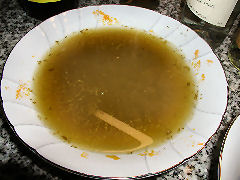 All that aside, as usual, I wanted to start with a soup. A classic from Hunan cooking is a soup based on watercress and jujubes. Not the little candies you buy in the movie theater to help you make it through Rocky XXIV, but the originals they’re modeled on – hóng zûo, Chinese dates, or red dates. While as indicated above, presentation isn’t my first concern, I do like dishes to look reasonably pretty. Though the flavors worked, I just couldn’t get this to look right, and tried variations each of the three nights we offered this dinner. The watercress, even after being blanched and shocked, kept turning a dark grey-green after a mere moment in the heat of the soup. I don’t know if there was some chemical reaction going on with the ingredients, I haven’t encountered that before with watercress. I guess about the only thing that might save the vivid bright green color would be to literally mix it in at the last moment of service. The soup itself is quite simple – chicken stock, sherry, a splash of soy sauce, sugar, and salt are all simmered together with the dates (remove the pits) and a dried yellow pepper, until the dates and pepper are soft. Then puree that. Meanwhile, blanch and shock the watercress – then you can either leave the leaves whole or chop them finely as well. Add to the soup and serve. Decorate with a little powdered yellow pepper.
All that aside, as usual, I wanted to start with a soup. A classic from Hunan cooking is a soup based on watercress and jujubes. Not the little candies you buy in the movie theater to help you make it through Rocky XXIV, but the originals they’re modeled on – hóng zûo, Chinese dates, or red dates. While as indicated above, presentation isn’t my first concern, I do like dishes to look reasonably pretty. Though the flavors worked, I just couldn’t get this to look right, and tried variations each of the three nights we offered this dinner. The watercress, even after being blanched and shocked, kept turning a dark grey-green after a mere moment in the heat of the soup. I don’t know if there was some chemical reaction going on with the ingredients, I haven’t encountered that before with watercress. I guess about the only thing that might save the vivid bright green color would be to literally mix it in at the last moment of service. The soup itself is quite simple – chicken stock, sherry, a splash of soy sauce, sugar, and salt are all simmered together with the dates (remove the pits) and a dried yellow pepper, until the dates and pepper are soft. Then puree that. Meanwhile, blanch and shock the watercress – then you can either leave the leaves whole or chop them finely as well. Add to the soup and serve. Decorate with a little powdered yellow pepper.
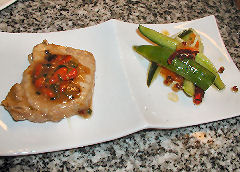 This is a combination of two Szechuan based dishes. The pork is loosely based on a honey lacquered ham dish that is quite typical. I might have gone with ham if I’d have found good cured ham steaks… but I’m glad I didn’t, I love the way this turned out. I used a boneless pork loin, and sliced it into medallions about half an inch thick. I marinated them for several hours in a mix of chopped scallions, shredded ginger, szechuan peppercorns, goji (Chinese wolfberries), salt, mirin (sweet sake), honey, and a rosa mosqueta (rosehip) liqueur. The latter was a substitute for cassia flower wine which is a classic in the dish, the wolfberries are my own addition to the dish. Then I simply sauteed the medallions in a splash of oil, after lightly browning on both sides, I added the marinade to the pan and let it cook down until it caramelized, flipping the medallions regularly to make sure they were well coated. It’s a fairly sweet dish, and would classically be served with something spicy on the side. I knew I wanted to use that Szechuan pickle recipe somewhere in the meal, and this seemed the perfect place. So I served them with the spicy pickles, well chilled – giving not only contrasting and balancing flavors, but texture and temperature contrasts as well.
This is a combination of two Szechuan based dishes. The pork is loosely based on a honey lacquered ham dish that is quite typical. I might have gone with ham if I’d have found good cured ham steaks… but I’m glad I didn’t, I love the way this turned out. I used a boneless pork loin, and sliced it into medallions about half an inch thick. I marinated them for several hours in a mix of chopped scallions, shredded ginger, szechuan peppercorns, goji (Chinese wolfberries), salt, mirin (sweet sake), honey, and a rosa mosqueta (rosehip) liqueur. The latter was a substitute for cassia flower wine which is a classic in the dish, the wolfberries are my own addition to the dish. Then I simply sauteed the medallions in a splash of oil, after lightly browning on both sides, I added the marinade to the pan and let it cook down until it caramelized, flipping the medallions regularly to make sure they were well coated. It’s a fairly sweet dish, and would classically be served with something spicy on the side. I knew I wanted to use that Szechuan pickle recipe somewhere in the meal, and this seemed the perfect place. So I served them with the spicy pickles, well chilled – giving not only contrasting and balancing flavors, but texture and temperature contrasts as well.
Ma La Hwong Gua (Szechuan Pickles)
1½ pounds thin, seedless cucumbers
1 tablespoon salt
10 slices ginger, shredded
1 fresh hot red pepper, shredded
½ cup sesame oil
5 dried hot red peppers cut into 1″ pieces
1 tablespoon Szechuan peppercorns
5 tablespoons rice vinegar
2 tablespoons sugarRemove tips from cucumbers but do not peel. Cut each in half lengthwise and then into four sections. Mix with salt and allow to stand for 30 minutes. Rinse in cold water and drain. Place in bowl and sprinkle with ginger and fresh red pepper. Stir fry szechuan pepper in sesame oil until fragrant. Add dried peppers and fry briefly. Pour hot oil and peppers over cucumbers, then add vinegar and sugar. Refrigerate for a minimum of six hours before serving, mixing the pickles up with the marinade every hour or so to keep them well coated.
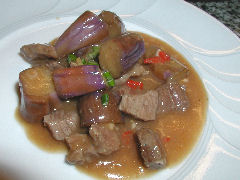 Moving back to the Hunan province, I wanted to go with a dish that would start to move us in a more picante direction. This is a medium hot dish of eggplant and beef, you can substitute other meats for the beef, or even leave it out entirely if you want a really delicious vegetarian dish. The beef is cut into small pieces, traditionally it’s actually nearly ground it’s chopped so fine, and it becomes part of the sauce, but I’ve tried it both ways and simply like it better cut into small pieces – about ¼-½” cubes. The beef is marinated for a couple of hours in salt, aji-no-moto (msg), mirin, sesame oil, peanut oil, and cornstarch. The eggplant is cut into bite sized pieces – and I prefer to use the thin Chinese/Japanese eggplants, the texture and flavor works better, but you can use whatever is available – then fairly heavily salted and left to drain for an hour, after which rinse the pieces well in cold water and set them aside to dry off. When ready to cook, saute the eggplant in very hot peanut oil (or other high temperature cooking oil). When the pieces are lightly browned and starting to soften, add a mix of shredded ginger, thinly sliced red chilies, chopped garlic, a dollop of miso paste, a bit of Chinese red vinegar, and some freshly ground black pepper. Stir fry for a minute or two to develop the aromatics in the mixture. Then add the beef and continue cooking, stirring regularly, until the beef is lightly browned. Add just enough beef stock to about simmer the mixture in, and cover the pan. Let it continue to cook for about five minutes. Then uncover and finish with a mixture of soy sauce, mirin, chili oil, and cornstarch all stirred together in a sort of slurry. Continue cooking to let the sauce thicken from the cornstarch. Obviously, you can change the “heat” of the dish both with the amount of the chilies and whether you leave the seeds in – I do – and with how much chili oil you add at the end.
Moving back to the Hunan province, I wanted to go with a dish that would start to move us in a more picante direction. This is a medium hot dish of eggplant and beef, you can substitute other meats for the beef, or even leave it out entirely if you want a really delicious vegetarian dish. The beef is cut into small pieces, traditionally it’s actually nearly ground it’s chopped so fine, and it becomes part of the sauce, but I’ve tried it both ways and simply like it better cut into small pieces – about ¼-½” cubes. The beef is marinated for a couple of hours in salt, aji-no-moto (msg), mirin, sesame oil, peanut oil, and cornstarch. The eggplant is cut into bite sized pieces – and I prefer to use the thin Chinese/Japanese eggplants, the texture and flavor works better, but you can use whatever is available – then fairly heavily salted and left to drain for an hour, after which rinse the pieces well in cold water and set them aside to dry off. When ready to cook, saute the eggplant in very hot peanut oil (or other high temperature cooking oil). When the pieces are lightly browned and starting to soften, add a mix of shredded ginger, thinly sliced red chilies, chopped garlic, a dollop of miso paste, a bit of Chinese red vinegar, and some freshly ground black pepper. Stir fry for a minute or two to develop the aromatics in the mixture. Then add the beef and continue cooking, stirring regularly, until the beef is lightly browned. Add just enough beef stock to about simmer the mixture in, and cover the pan. Let it continue to cook for about five minutes. Then uncover and finish with a mixture of soy sauce, mirin, chili oil, and cornstarch all stirred together in a sort of slurry. Continue cooking to let the sauce thicken from the cornstarch. Obviously, you can change the “heat” of the dish both with the amount of the chilies and whether you leave the seeds in – I do – and with how much chili oil you add at the end.
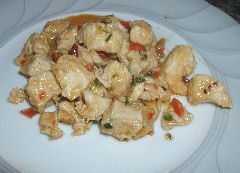 I played around on the different nights with the amount of sauce and the quantities of the various ingredients to make the Kung Pao Chicken. While I like the look of this first version the best, I like the flavors of the final version better. Somewhere in there it all comes together. What was most interesting was that this being the spiciest dish, was the one I thought might get a little negative reaction from some of the folks attending – you never know with a big group, and, of course, there’s the legendary Argentine aversion to picante dishes. But, with the gradual buildup to the spicier level, and, I think, the willingness to try something new (several folk had never tried anything like these dishes, and initially were wary), everyone cleaned their plates. I was particularly gratified to hear from one of the guests who has travelled all over the world and had told me in advance that Kung Pao was a personal favorite dish (as it is with me), that this was quite possibly the best she’d ever had!
I played around on the different nights with the amount of sauce and the quantities of the various ingredients to make the Kung Pao Chicken. While I like the look of this first version the best, I like the flavors of the final version better. Somewhere in there it all comes together. What was most interesting was that this being the spiciest dish, was the one I thought might get a little negative reaction from some of the folks attending – you never know with a big group, and, of course, there’s the legendary Argentine aversion to picante dishes. But, with the gradual buildup to the spicier level, and, I think, the willingness to try something new (several folk had never tried anything like these dishes, and initially were wary), everyone cleaned their plates. I was particularly gratified to hear from one of the guests who has travelled all over the world and had told me in advance that Kung Pao was a personal favorite dish (as it is with me), that this was quite possibly the best she’d ever had!
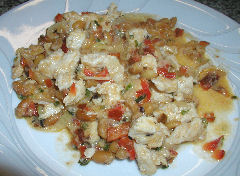 Okay, this is enough to serve twelve folk at the end of a tasting menu, or about six if it’s the primary course in a shorter menu. Basically, use one chicken breast per person, or slightly less, and adjust accordingly. Prepare everything in advance, this goes really fast…
Okay, this is enough to serve twelve folk at the end of a tasting menu, or about six if it’s the primary course in a shorter menu. Basically, use one chicken breast per person, or slightly less, and adjust accordingly. Prepare everything in advance, this goes really fast…
Kung Pao Chicken
9 chicken breasts, cut in bite-sized cubes
¼ cup soy sauce
¼ cup mirin
2 tablespoons grated ginger
½ cup cornstarchMarinate the chicken cubes in the rest of the ingredients for 1-2 hours.
1 large white onion, thinly sliced
6-8 garlic cloves, thinly sliced
1 large red bell pepper, chopped
½ cup finely chopped garlic chives
¼ cup finely shredded ginger
¼ cup thinly sliced hot red chilies
¼ cup dried hot peppers cut in ½” lengths
1 cup raw peanuts
¼ cup peanut oilHeat the peanut oil very hot in a large wok or other deep frying pan or dutch oven. Add the onions and stir fry until limp but not browned. Add the garlic and ginger and continue to stir-fry for a minute. Add the garlic chives, and the three peppers, and continue to cook for 2-3 minutes. Add the peanuts, and continue another 1-2 minutes until the peanuts are just lightly toasted. Add the chicken mixture. Given the quantity, the chicken needs to be stirred up regularly. What I do is cover the pan and let it cook for 1-2 minutes, then uncover, stir it all up, re-cover, etc. until the chicken is cooked through. It takes about 8-10 minutes for this quantity – if you’re making a smaller amount it will take less time, and you may not even need to cover it.
½ cup chicken stock
2 tablespoons soy sauce
2 tablespoons mirin
2 tablespoons sugar
2 tablespoons cornstarch
salt to taste, roughly 1 tablespoonMix these together and then pour over the chicken at the end, tossing to distribute the final seasoning well and allow the sauce to thicken with the cornstarch. Serve – with or without rice…
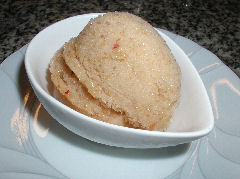 After building to a high point on the spicy scale, it was time to cool the palate off a bit. A fairly classic flavor combination in Hunan desserts are fresh peaches with a little honey and mint. I decided to make it into a cooling sorbet. Dissolve one cup of sugar and one cup of honey in one cup of water over low heat. Add ¼ cup of chopped fresh mint leaves, or a couple of tablespoons of dried. Let infuse while it cools. Strain this liquid into the blender. Add four peaches, pitted but not peeled. Blend until as smooth as you can get it. Chill, process in an ice cream maker. Serve. This makes about a quart of sorbet.
After building to a high point on the spicy scale, it was time to cool the palate off a bit. A fairly classic flavor combination in Hunan desserts are fresh peaches with a little honey and mint. I decided to make it into a cooling sorbet. Dissolve one cup of sugar and one cup of honey in one cup of water over low heat. Add ¼ cup of chopped fresh mint leaves, or a couple of tablespoons of dried. Let infuse while it cools. Strain this liquid into the blender. Add four peaches, pitted but not peeled. Blend until as smooth as you can get it. Chill, process in an ice cream maker. Serve. This makes about a quart of sorbet.
I leave you with a joke that I remember a Chinese comedian once telling – I can’t remember who… he was in front of a typical New York City audience, i.e.,, heavy on the local Jewish population… “It’s the year 4704 on the Chinese calendar… It’s the year 5767 on the Hebrew Calendar… What did you people do for food for that first thousand years?” God only knows. But if Moses was smart out there in the desert, they were whipping up Kung Pao Manna…
Please give some guidance about garlic chives. Do you mean garlic greens, that which is attached to garlic and usually tossed out?
No, garlic chives are a different herb. I’m not sure what guidance to give, they’re pretty common in most Asian markets. They look like a sort of flat ribbon of a chive, and often have a small flower bud on the tip.
The photo is quite helpful. I’ll look for them in Boston’s Chinatown.
[…] I like it, but it was not the kind they make at the restaurant. So continuing on my search, I found this recipe at Casa SaltShaker, who I only wish I had known about when I was in Uruguay and Argentina! Using […]
[…] in olive oil. For contrast to all that richness, some slices of roasted beets and some slices of spicy cucumber pickles, and some cilantro leaves and fennel fronds. Complicated as hell, but I think it was worth it […]
[…] of chili, five-spice, soy, garlic, miso and sherry, served up with watermelon rind pickles and spicy szechuan pickles. But I wasn’t happy with the presentation and then I thought I’d do it all laid out […]
[…] First up was a Szechuan class that began with making a batch of my favorite spicy pickles. […]
[…] though they’re delicious ways to do things, instead, I went and made a big batch of my fiery hot Szechuan pickles – with the addition of a little peanut oil just to have enough liquid to fill the jars […]
[…] basil, salt and pepper. Served with lightly seared palm hearts, salted yogurt, chives, and a spicy szechuan pickle sorbet (seedless cucumbers, sesame oil, ginger, fresh and dried chilies, szechuan peppercorns, rice […]
[…] there were plenty of dishes that I truly loved – making really good Kung Pao Chicken, a Beef Rendang from Indonesia, and probably my favorite, a four onion tart for a wine tasting […]